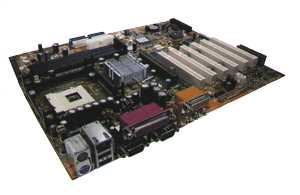 |
THE MOTHERBOARD THE BASICS V. Ryan © 2002 |
 |
THE MOTHERBOARD THE BASICS V. Ryan © 2002 |
|
All the parts that make up a computer are known as hardware. The most important part of the computer is the ‘mother board’. (Photograph shown above and simplified diagram below) |
|
|
|
|
| THE BIOS (ROM) | |
|
The BIOS chip contains all the basic instructions that
manages the computer when it is switched on. Read Only Memory is permanent memory. When the
computer is turned on the PROCESSOR looks for basic data/information in the
ROM (BIOS). The processor needs to know how much memory is present, if a hard drive
is connected and other vital pieces of information. Without this basic
information the computer will not work. The processor searches for this
information automatically. |
|
| DIMM SOCKETS (RAM) | |
|
The computers memory is Random-Access Memory and it is pushed into the dimm sockets. This is temporary memory and is used to store data while the computer is on. If the computer is turned off all the data is lost. RAM holds data that the computer has to constantly check in order for the software you are using to work properly. Files that are in constant use are held in the RAM. |
|
| EPROM | |
|
EPROM or Erasable, Programmable, Read Only, Memory. It is possible to write to and read from this type of memory. Usually this is found in small hand-held computers. Often it can be removed from the computer in the form of a ‘cassette’. It works a little like a floppy diskette. The motherboard shown above does not have EPROM memory. |
|
| THE CHIPSET | |
| The chipset directs the data moving around the computer to the right places. | |
| SLOTS | |
|
There are usually two types of slots on the motherboard. AGP slots are for graphics cards whilst PCI slots are for devices such as modems, network cards and sound cards etc... |
|
|
|
|
| ONBOARD SOUND | |
|
Many motherboards do not require a separate sound card as they have onboard sound capabilities. Onboard sound is normally quite basic and an extra sound card is only needed if the computer system is to be used for serious sound/audio work. |
|
| PORTS | |
|
All computers have ports. These include PS/2 ports for keyboard and mouse connections, a parallel port for a printer and scanner, serial ports for external modems and possibly a mouse, a number of USB ports for connecting devices such as digital cameras and finally firewire connectors for digital camcorders. |
|
| FLOPPY CONNECTOR | |
| The computer's floppy drive (also known as the 'A' drive) is connected here. | |
| IDE CONNECTOR | |
|
The hard disk, CD and DVD are connected to these. It is usually possible to connect up to two devices to each IDE connector. |
|
| THE PROCESSOR | |
|
The processor is inserted into the processor socket. This carries out most of the work controlling most functions of the computer. A processor may look a little like a black square but internally it is a highly complex piece of electronic engineering. Companies such as INTEL and AMD make processors. |
|